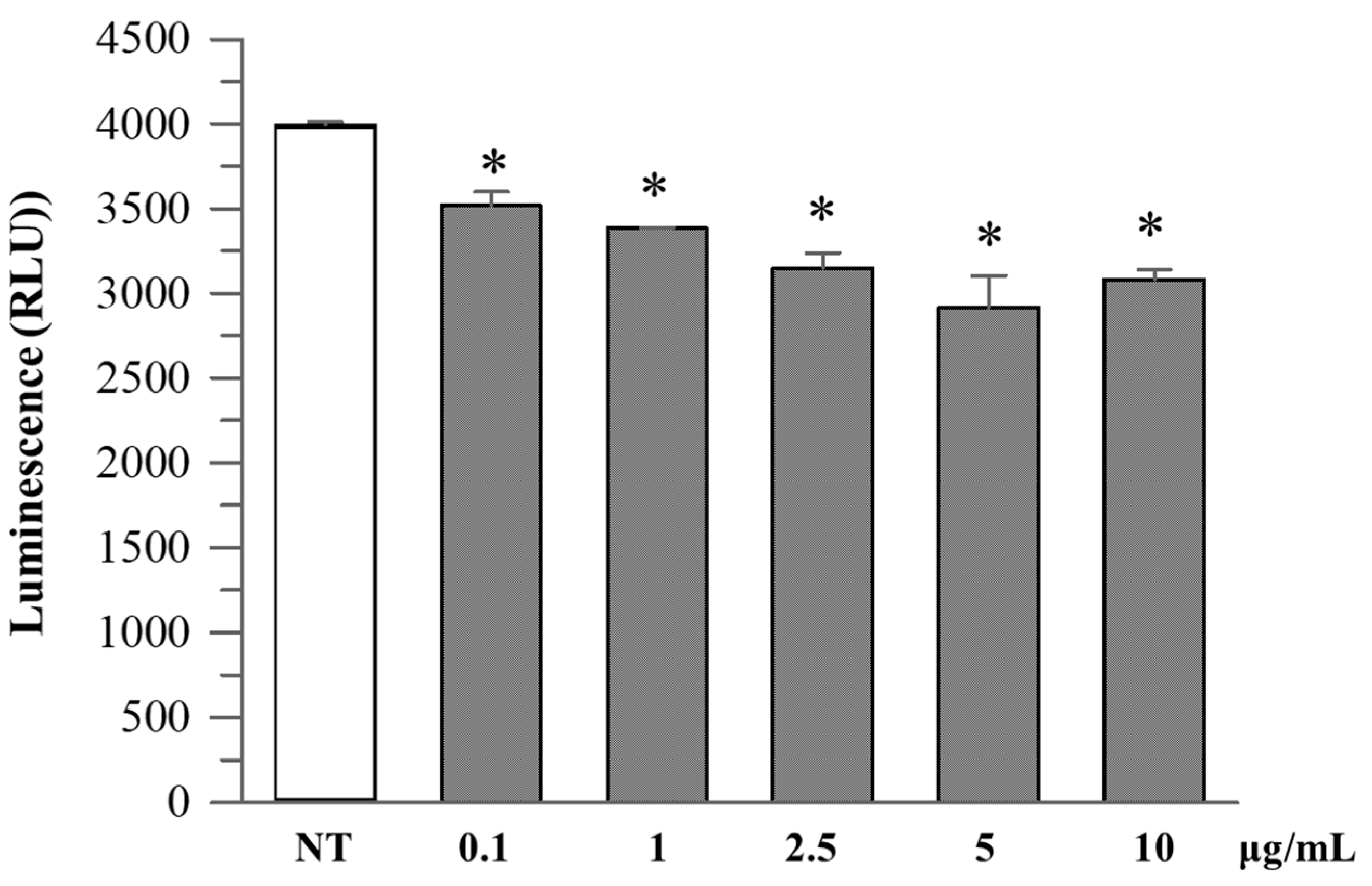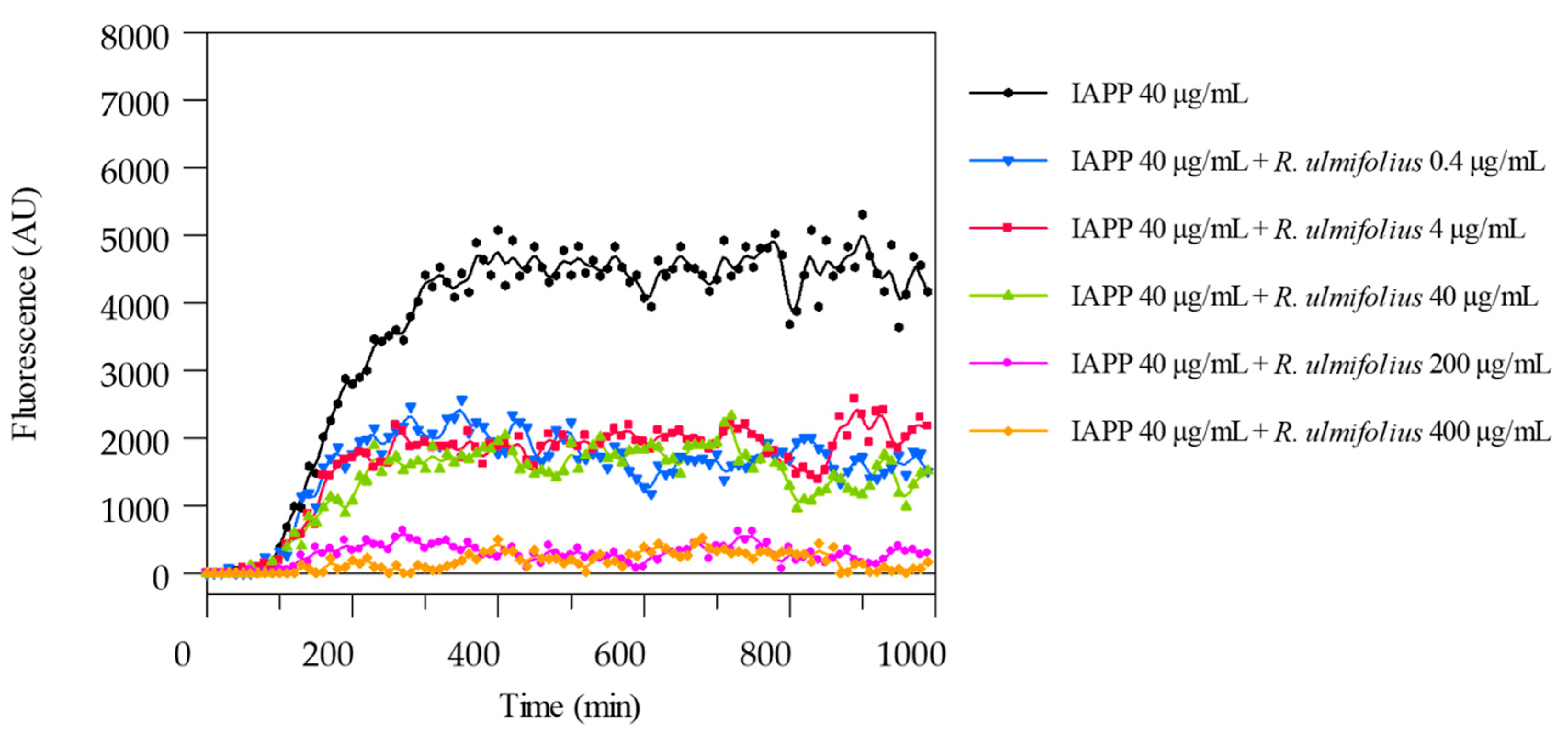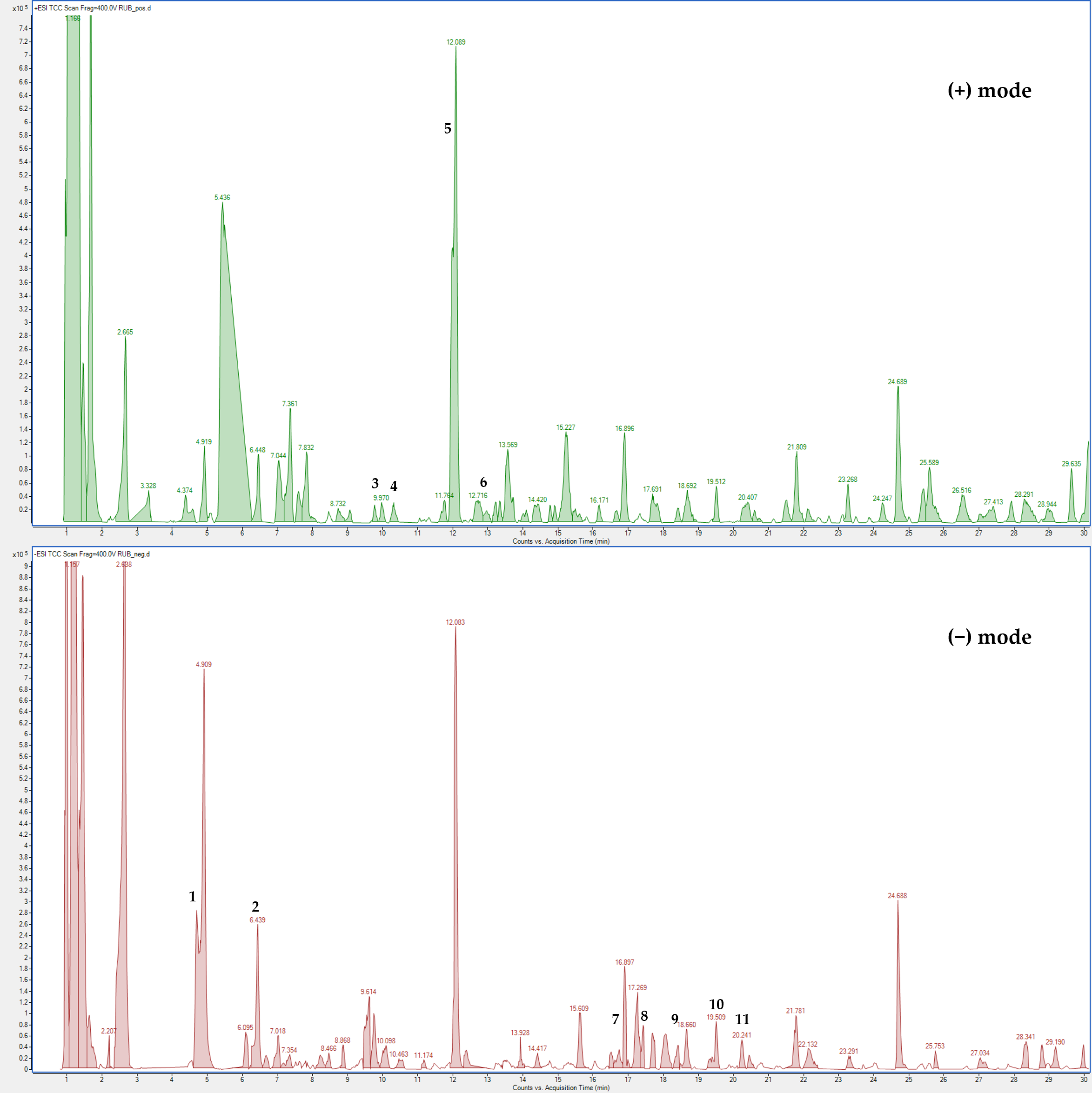Inhibition of α-Glucosidase Activity and Islet Amyloid PolyPeptide Fibril Formation by Rubus ulmifolius Fruit Extract: A Potential Therapeutic Approach for Type 2 Diabetes Mellitus
Abstract
1. Introduction
2. Results
2.1. α-Amylase and α-Glucosidase Inhibition
2.2. ABTS Radical Scavenging Activity and Determination of the Total Phenolics and Flavonoids
2.3. Cell Viability and Intracellular ROS Levels
2.4. Modulation of Caspase-1 Activity by R. ulmifolius in Caco-2 Cells
2.5. Inhibition of IAPP Aggregate Formation
2.6. Quali-Quantitative Determination of Phenolic Compounds in R. ulmifolius Fruit Extract
3. Discussion
4. Materials and Methods
4.1. Reagents and Standards
4.2. Plant Material
4.3. Extract Preparation
4.4. α-Amylase and α-Glucosidase Inhibition Assay
4.5. ABTS Radical Scavenging Activity
4.6. Determination of the Total Phenolics and Flavonoids
4.7. Cell Culture, Cell Viability and Intracellular ROS Levels
4.8. Caspase-1 Activity Assay
4.9. Inhibition of IAPP Aggregate Formation
4.10. High-Resolution LC-ESI-QToF-MS-MS and HPLC-PDA Analysis
4.11. Statistical Analysis
5. Conclusions
Supplementary Materials
Author Contributions
Funding
Institutional Review Board Statement
Data Availability Statement
Acknowledgments
Conflicts of Interest
Abbreviations
| T2D | Type 2 diabetes |
| IAPP | Islet amyloid polypeptide |
| ThT | Thioflavin T |
| ROS | Reactive oxygen species |
| ABTS | 2,2′-Azinobis-(3-Ethylbenzothiazoline-6-Sulfonic Acid) |
| GAE | Gallic Acid Equivalent |
| QE | Quercetin Equivalent |
| dw | Dried weight |
| MTT | 3-(4,5-dimethylthiazol-2-yl)-2,5-diphenyltetrazolium bromide assay |
| DCFHDA | 2′,7′-dichlorofluorescein diacetate |
| HPLC-PDA | High-Performance Liquid Chromatography/Photodiode Array Detector |
| LC-MS | Liquid Chromatography–Mass Spectrometry |
| TCC | Total Compound Chromatogram |
| DMSO | Dimethyl sulfoxide |
| DMEM | Dulbecco’s Modified Eagle’s Medium |
| FBS | Fetal Bovine Serum |
References
- Saeedi, P.; Petersohn, I.; Salpea, P.; Malanda, B.; Karuranga, S.; Unwin, N.; Colagiuri, S.; Guariguata, L.; Motala, A.A.; Ogurtsova, K.; et al. Global and Regional Diabetes Prevalence Estimates for 2019 and Projections for 2030 and 2045: Results from the International Diabetes Federation Diabetes Atlas, 9th Edition. Diabetes Res. Clin. Pract. 2019, 157, 107843. [Google Scholar] [CrossRef]
- Roham, P.H.; Save, S.N.; Sharma, S. Human islet amyloid polypeptide: A therapeutic target for the management of type 2 diabetes mellitus. J. Pharm. Anal. 2022, 12, 556–569. [Google Scholar] [CrossRef]
- Fiorentino, T.; Prioletta, A.; Zuo, P.; Folli, F. Hyperglycemia-Induced Oxidative Stress and Its Role in Diabetes Mellitus Related Cardiovascular Diseases. Curr. Pharm. Des. 2013, 19, 5695–5703. [Google Scholar] [CrossRef]
- Stienstra, R.; Joosten, L.A.B.; Koenen, T.; Van Tits, B.; Van Diepen, J.A.; Van Den Berg, S.A.A.; Rensen, P.C.N.; Voshol, P.J.; Fantuzzi, G.; Hijmans, A.; et al. The Inflammasome-Mediated Caspase-1 Activation Controls Adipocyte Differentiation and Insulin Sensitivity. Cell Metab. 2010, 12, 593–605. [Google Scholar] [CrossRef] [PubMed]
- Alkhatib, A.; Tsang, C.; Tiss, A.; Bahorun, T.; Arefanian, H.; Barake, R.; Khadir, A.; Tuomilehto, J. Functional Foods and Lifestyle Approaches for Diabetes Prevention and Management. Nutrients 2017, 9, 1310. [Google Scholar] [CrossRef] [PubMed]
- Mirmiran, P.; Bahadoran, Z.; Azizi, F. Functional Foods-Based Diet as a Novel Dietary Approach for Management of Type 2 Diabetes and Its Complications: A Review. World J. Diabetes 2014, 5, 267–281. [Google Scholar] [CrossRef] [PubMed]
- Lam, T.-P.; Tran, N.-V.N.; Pham, L.-H.D.; Lai, N.V.-T.; Dang, B.-T.N.; Truong, N.-L.N.; Nguyen-Vo, S.-K.; Hoang, T.-L.; Mai, T.T.; Tran, T.-D. Flavonoids as dual-target inhibitors against α-glucosidase and α-amylase: A systematic review of in vitro studies. Nat. Prod. Bioprospect. 2024, 14, 4. [Google Scholar] [CrossRef]
- Cosme, F.; Pinto, T.; Aires, A.; Morais, M.C.; Bacelar, E.; Anjos, R.; Ferreira-Cardoso, J.; Oliveira, I.; Vilela, A.; Gonçalves, B. Red Fruits Composition and Their Health Benefits-A Review. Foods 2022, 11, 644. [Google Scholar] [CrossRef]
- Alam, S.; Sarker, M.M.R.; Sultana, T.N.; Chowdhury, M.N.R.; Rashid, M.A.; Chaity, N.I.; Zhao, C.; Xiao, J.; Hafez, E.E.; Khan, S.A.; et al. Antidiabetic Phytochemicals From Medicinal Plants: Prospective Candidates for New Drug Discovery and Development. Front. Endocrinol. 2022, 13, 800714. [Google Scholar] [CrossRef]
- Schulz, M.; Seraglio, S.K.T.; Della Betta, F.; Nehring, P.; Valese, A.C.; Daguer, H.; Gonzaga, L.V.; Costa, A.C.O.; Fett, R. Blackberry (Rubus ulmifolius Schott): Chemical Composition, Phenolic Compounds and Antioxidant Capacity in Two Edible Stages. Food Res. Int. 2019, 122, 627–634. [Google Scholar] [CrossRef]
- Atzei, A.D. Le Piante Nella Tradizione Popolare Della Sardegna; Carlo Delfino Editore: Sassari, Italy, 2003. [Google Scholar]
- Guarrera, P.M. Traditional Phytotherapy in Central Italy (Marche, Abruzzo, and Latium). Fitoterapia 2005, 76, 1–25. [Google Scholar] [CrossRef]
- Lemus, I.; García, R.; Delvillar, E.; Knop, G. Hypoglycaemic Activity of Four Plants Used in Chilean Popular Medicine. Phytother. Res. 1999, 2, 91–94. [Google Scholar] [CrossRef]
- Ali, N.; Shaoib, M.; Shah, S.W.A.; Shah, I.; Shuaib, M. Pharmacological Profile of the Aerial Parts of Rubus ulmifolius Schott. BMC Complement. Altern. Med. 2017, 17, 59. [Google Scholar] [CrossRef]
- Tabarki, S.; Aouadhi, C.; Mechergui, K.; Hammi, K.M.; Ksouri, R.; Raies, A.; Toumi, L. Comparison of Phytochemical Composition and Biological Activities of Rubus ulmifolius Extracts Originating from Four Regions of Tunisia. Chem. Biodivers. 2017, 14, e1600168. [Google Scholar] [CrossRef]
- da Silva, L.P.; Pereira, E.; Pires, T.C.S.P.; Alves, M.J.; Pereira, O.R.; Barros, L.; Ferreira, I.C.F.R. Rubus ulmifolius Schott Fruits: A Detailed Study of Its Nutritional, Chemical and Bioactive Properties. Food Res. Int. 2019, 119, 34–43. [Google Scholar] [CrossRef]
- Martins, M.S.; Gonçalves, A.C.; Alves, G.; Silva, L.R. Blackberries and Mulberries: Berries with Significant Health-Promoting Properties. Int. J. Mol. Sci. 2023, 24, 12024. [Google Scholar] [CrossRef] [PubMed]
- Gomez Mattson, M.; Sozzi, A.; Corfield, R.; Gagneten, M.; Franceschinis, L.; Schebor, C.; Salvatori, D. Colorant and Antioxidant Properties of Freeze-Dried Extracts from Wild Berries: Use of Ultrasound-Assisted Extraction Method and Drivers of Liking of Colored Yogurts. J. Food Sci. Technol. 2022, 59, 944–955. [Google Scholar] [CrossRef] [PubMed]
- Feng, R.; Bowman, L.L.; Lu, Y.; Leonard, S.S.; Shi, X.; Jiang, B.H.; Castranova, V.; Vallyathan, V.; Ding, M. Blackberry Extracts Inhibit Activating Protein 1 Activation and Cell Transformation by Perturbing the Mitogenic Signaling Pathway. Nutr. Cancer 2004, 50, 80–89. [Google Scholar] [CrossRef] [PubMed]
- Loizzo, M.R.; Tundis, R.; Leporini, M.; D’urso, G.; Candela, R.G.; Falco, T.; Piacente, S.; Bruno, M.; Sottile, F. Almond (Prunus dulcis cv. casteltermini) Skin Confectionery By-Products: New Opportunity for the Development of a Functional Blackberry (Rubus ulmifolius Schott) Jam. Antioxidants 2021, 10, 1218. [Google Scholar] [CrossRef]
- van Jaarsveld, B.C.; Hackeng, W.H.; Lips, C.J.; Erkelens, D.W. Plasma concentrations of islet amyloid polypeptide after glucagon administration in type 2 diabetic patients and non-diabetic subjects. Diabet. Med. 1993, 10, 327–330. [Google Scholar] [CrossRef]
- Dührkop, K.; Fleischauer, M.; Ludwig, M.; Aksenov, A.A.; Melnik, A.V.; Meusel, M.; Dorrestein, P.C.; Rousu, J.; Böcker, S. SIRIUS 4: A Rapid Tool for Turning Tandem Mass Spectra into Metabolite Structure Information. Nat. Methods 2019, 16, 299–302. [Google Scholar] [CrossRef]
- Hoffmann, M.A.; Nothias, L.F.; Ludwig, M.; Fleischauer, M.; Gentry, E.C.; Witting, M.; Dorrestein, P.C.; Dührkop, K.; Böcker, S. High-Confidence Structural Annotation of Metabolites Absent from Spectral Libraries. Nat. Biotechnol. 2022, 40, 411–421. [Google Scholar] [CrossRef]
- KNApSAcK Core System. Available online: http://www.knapsackfamily.com/knapsack_core/top.php (accessed on 28 April 2025).
- Blaženović, I.; Kind, T.; Ji, J.; Fiehn, O. Software Tools and Approaches for Compound Identification of LC-MS/MS Data in Metabolomics. Metabolites 2018, 8, 31. [Google Scholar] [CrossRef]
- Liu, W.; Nisar, M.F.; Wan, C. Characterization of Phenolic Constituents from Prunus cerasifera Ldb Leaves. J. Chem. 2020, 2020, 5976090. [Google Scholar] [CrossRef]
- Truong, X.T.; Park, S.H.; Lee, Y.G.; Jeong, H.Y.; Moon, J.H.; Jeon, T. Il Protocatechuic Acid from Pear Inhibits Melanogenesis in Melanoma Cells. Int. J. Mol. Sci. 2017, 18, 1809. [Google Scholar] [CrossRef]
- Candela, R.G.; Lazzara, G.; Piacente, S.; Bruno, M.; Cavallaro, G.; Badalamenti, N. Conversion of Organic Dyes into Pigments: Extraction of Flavonoids from Blackberries (Rubus ulmifolius) and Stabilization. Molecules 2021, 26, 6278. [Google Scholar] [CrossRef]
- Pavlović, A.V.; Papetti, A.; Zagorac, D.Č.D.; Gašić, U.M.; Mišić, D.M.; Tešić, Ž.L.; Natić, M.M. Phenolics Composition of Leaf Extracts of Raspberry and Blackberry Cultivars Grown in Serbia. Ind. Crops Prod. 2016, 87, 304–314. [Google Scholar] [CrossRef]
- Kashchenko, N.I.; Olennikov, D.N. Phenolome of Asian Agrimony Tea (Agrimonia asiaticaJuz., Rosaceae): LC-MS Profile, α-Glucosidase Inhibitory Potential and Stability. Foods 2020, 9, 1348. [Google Scholar] [CrossRef] [PubMed]
- Renai, L.; Scordo, C.V.A.; Chiuminatto, U.; Ulaszewska, M.; Giordani, E.; Petrucci, W.A.; Tozzi, F.; Nin, S.; Bubba, M. Del Liquid Chromatographic Quadrupole Time-of-Flight Mass Spectrometric Untargeted Profiling of (Poly)Phenolic Compounds in Rubus idaeusL. and Rubus occidentalisL. Fruits and Their Comparative Evaluation. Antioxidants 2021, 10, 704. [Google Scholar] [CrossRef] [PubMed]
- Baby, B.; Antony, P.; Vijayan, R. Antioxidant and Anticancer Properties of Berries. Crit. Rev. Food Sci. Nutr. 2018, 58, 2491–2507. [Google Scholar] [CrossRef] [PubMed]
- Tavares, L.; Figueira, I.; McDougall, G.J.; Vieira, H.L.A.; Stewart, D.; Alves, P.M.; Ferreira, R.B.; Santos, C.N. Neuroprotective Effects of Digested Polyphenols from Wild Blackberry Species. Eur. J. Nutr. 2013, 52, 225–236. [Google Scholar] [CrossRef]
- Aoki, K.; Muraoka, T.; Ito, Y.; Togashi, Y.; Terauchi, Y. Comparison of adverse gastrointestinal effects of acarbose and miglitol in healthy men: A crossover study. Intern. Med. 2010, 49, 1085–1087. [Google Scholar] [CrossRef] [PubMed]
- Xu, J.; Su, X.; Li, Y.; Sun, X.; Wang, D.; Wang, W. Response of Bioactive Phytochemicals in Vegetables and Fruits to Environmental Factors. Eur. J. Nutr. Food Saf. 2019, 9, 233–247. [Google Scholar] [CrossRef]
- Vickers, C.E.; Gershenzon, J.; Lerdau, M.T.; Loreto, F. A Unified Mechanism of Action for Volatile Isoprenoids in Plant Abiotic Stress. Nat. Chem. Biol. 2009, 5, 283–291. [Google Scholar] [CrossRef]
- Jimenez-Garcia, S.N.; Vazquez-Cruz, M.A.; Guevara-Gonzalez, R.G.; Torres-Pacheco, I.; Cruz-Hernandez, A.; Feregrino-Perez, A.A. Current Approaches for Enhanced Expression of Secondary Metabolites as Bioactive Compounds in Plants for Agronomic and Human Health Purposes—A Review. Pol. J. Food Nutr. Sci. 2013, 63, 67–78. [Google Scholar] [CrossRef]
- Lapornik, B.; Prošek, M.; Wondra, A.G. Comparison of Extracts Prepared from Plant By-Products Using Different Solvents and Extraction Time. J. Food Eng. 2005, 71, 214–222. [Google Scholar] [CrossRef]
- Castañeda-Ovando, A.; Pacheco-Hernández, M.d.L.; Páez-Hernández, M.E.; Rodríguez, J.A.; Galán-Vidal, C.A. Chemical Studies of Anthocyanins: A Review. Food Chem. 2009, 113, 859–871. [Google Scholar] [CrossRef]
- Cásedas, G.; Les, F.; González-Burgos, E.; Gómez-Serranillos, M.P.; Smith, C.; López, V. Cyanidin-3-O-Glucoside Inhibits Different Enzymes Involved in Central Nervous System Pathologies and Type-2 Diabetes. S. Afr. J. Bot. 2019, 120, 241–246. [Google Scholar] [CrossRef]
- Gowd, V.; Karim, N.; Xie, L.; Shishir, M.R.I.; Xu, Y.; Chen, W. In Vitro Study of Bioaccessibility, Antioxidant, and α-Glucosidase Inhibitory Effect of Pelargonidin-3-O-Glucoside after Interacting with Beta-Lactoglobulin and Chitosan/Pectin. Int. J. Biol. Macromol. 2020, 154, 380–389. [Google Scholar] [CrossRef]
- Cardullo, N.; Muccilli, V.; Pulvirenti, L.; Cornu, A.; Pouységu, L.; Deffieux, D.; Quideau, S.; Tringali, C. C-Glucosidic Ellagitannins and Galloylated Glucoses as Potential Functional Food Ingredients with Anti-Diabetic Properties: A Study of α-Glucosidase and α-Amylase Inhibition. Food Chem. 2020, 313, 126099. [Google Scholar] [CrossRef]
- Bellesia, A.; Verzelloni, E.; Tagliazucchi, D. Pomegranate Ellagitannins Inhibit α-Glucosidase Activity in Vitro and Reduce Starch Digestibility under Simulated Gastro-Intestinal Conditions. Int. J. Food Sci. Nutr. 2015, 66, 85–92. [Google Scholar] [CrossRef]
- Zhizhou, L.; Hui, W.; Shiwei, S.; Zhongbai, S.; Chaoyi, L.; Xiaoyue, D.; Lu, W.; Wei, W. Ellagitannins from Pomegranate (Punica granatum L.) Flower with Xanthine Oxidase and α-Glucosidase Inhibitory Activities. J. Funct. Foods 2024, 116, 106153. [Google Scholar] [CrossRef]
- Şöhretoğlu, D.; Sari, S.; Barut, B.; Özel, A. Discovery of Potent α-Glucosidase Inhibitor Flavonols: Insights into Mechanism of Action through Inhibition Kinetics and Docking Simulations. Bioorg. Chem. 2018, 79, 257–264. [Google Scholar] [CrossRef]
- Khalid, M.; Petroianu, G.; Adem, A. Advanced Glycation End Products and Diabetes Mellitus: Mechanisms and Perspectives. Biomolecules 2022, 12, 542. [Google Scholar] [CrossRef]
- Croden, J.; Silva, J.R.; Huang, W.; Gupta, N.; Fu, W.; Matovinovic, K.; Black, M.; Li, X.; Chen, K.; Wu, Y.; et al. Cyanidin-3-O-Glucoside Improves the Viability of Human Islet Cells Treated with Amylin or Aβ1-42 in Vitro. PLoS ONE 2021, 16, e0258208. [Google Scholar] [CrossRef]
- Zhytniakivska, O.; Chaturvedi, T.; Thomsen, M.H. Plant-Based Inhibitors of Protein Aggregation. Biomolecules 2025, 15, 481. [Google Scholar] [CrossRef]
- Fais, A.; Era, B.; Di Petrillo, A.; Floris, S.; Piano, D.; Montoro, P.; Tuberoso, C.I.G.; Medda, R.; Pintus, F. Selected Enzyme Inhibitory Effects of Euphorbia characias Extracts. BioMed Res. Int. 2018, 2018, 1219367. [Google Scholar] [CrossRef]
- Delogu, G.L.; Matos, M.J.; Fanti, M.; Era, B.; Medda, R.; Pieroni, E.; Fais, A.; Kumar, A.; Pintus, F. 2-Phenylbenzofuran Derivatives as Butyrylcholinesterase Inhibitors: Synthesis, Biological Activity and Molecular Modeling. Bioorg. Med. Chem. Lett. 2016, 26, 2308–2313. [Google Scholar] [CrossRef] [PubMed]
- Singleton, V.L.; Rossi, J.A. Colorimetry of Total Phenolics with Phosphomolybdic-Phosphotungstic Acid Reagents. Am. J. Enol. Vitic. 1965, 16, 144–158. [Google Scholar] [CrossRef]
- Pintus, F.; Spanò, D.; Corona, A.; Medda, R. Antityrosinase Activity of Euphorbia Characias Extracts. PeerJ 2015, 3, e1305. [Google Scholar] [CrossRef]
- Hudson, S.A.; Ecroyd, H.; Kee, T.W.; Carver, J.A. The Thioflavin T Fluorescence Assay for Amyloid Fibril Detection Can Be Biased by the Presence of Exogenous Compounds. FEBS J. 2009, 276, 5960–5972. [Google Scholar] [CrossRef]
- De Luca, M.; Tuberoso, C.I.G.; Pons, R.; García, M.T.; Morán, M.d.C.; Ferino, G.; Vassallo, A.; Martelli, G.; Caddeo, C. Phenolic Fingerprint, Bioactivity and Nanoformulation of Prunus spinosa L. Fruit Extract for Skin Delivery. Pharmaceutics 2023, 15, 1063. [Google Scholar] [CrossRef]
- De Luca, M.; Lucchesi, D.; Tuberoso, C.I.G.; Fernàndez-Busquets, X.; Vassallo, A.; Martelli, G.; Fadda, A.M.; Pucci, L.; Caddeo, C. Liposomal Formulations to Improve Antioxidant Power of Myrtle Berry Extract for Potential Skin Application. Pharmaceutics 2022, 14, 910. [Google Scholar] [CrossRef]







| Sample | α-Glucosidase | α-Amylase | ||
|---|---|---|---|---|
| Inhibition % (100 µg/mL) | IC50 (µg/mL) | Inhibition % (100 µg/mL) | IC50 (µg/mL) | |
| R. ulmifolius fruit extract | 99.8 | 2.80 ± 0.56 | 8.5 | >100 |
| Acarbose | 90.0 ± 7.3 | 8.04 ± 0.65 | ||
| Sample | ABTS EC50 (µg/mL) | Total Phenolic mg GAE/g dw | Flavonoid mg QE/g dw |
|---|---|---|---|
| R. ulmifolius extract | 72.42 ± 0.62 | 28.69 ± 0.92 | 5.12 ± 0.68 |
| Trolox | 3.4 ± 0.3 |
| Compound | No § | R. ulmifolius Fruit Extract (mg/g dw) | |
|---|---|---|---|
| Mean | ±SD | ||
| Total Anthocyanins | 29.16 | ±2.04 | |
| cyanidin-3-O-glucoside | 3 | 25.18 | ±1.76 |
| pelargonidin-3-O-glucoside | 4 | 2.92 | ±0.18 |
| cyanidin-3-O-xyloside a | 5 | 0.39 | ±0.04 |
| cyanidin-3-O-dioxalyl-glucoside a | 6 | 0.67 | ±0.03 |
| Total Flavonols | 0.74 | ±0.07 | |
| quercetin-HMG-glucoside b | 10 | 0.36 | ±0.04 |
| kaempferol derivative c | 11 | 0.38 | ±0.02 |
| Total Ellagitannins | 2.04 | ±0.16 | |
| ellagic acid pentoside d | 7 | 0.69 | ±0.03 |
| ellagic acid glucuronide d | 9 | 1.35 | ±0.07 |
| Total Hydroxycinnamic acid | 0.77 | ±0.05 | |
| chlorogenic acid | 2 | 0.77 | ±0.05 |
| Total polyphenols | 32.71 | ±2.29 | |
Disclaimer/Publisher’s Note: The statements, opinions and data contained in all publications are solely those of the individual author(s) and contributor(s) and not of MDPI and/or the editor(s). MDPI and/or the editor(s) disclaim responsibility for any injury to people or property resulting from any ideas, methods, instructions or products referred to in the content. |
© 2025 by the authors. Licensee MDPI, Basel, Switzerland. This article is an open access article distributed under the terms and conditions of the Creative Commons Attribution (CC BY) license (https://creativecommons.org/licenses/by/4.0/).
Share and Cite
Floris, S.; Noli, B.; Cocco, C.; Fais, A.; Era, B.; Tuberoso, C.I.G.; Masala, V.; Piras, F.; Sogos, V.; Di Petrillo, A.; et al. Inhibition of α-Glucosidase Activity and Islet Amyloid PolyPeptide Fibril Formation by Rubus ulmifolius Fruit Extract: A Potential Therapeutic Approach for Type 2 Diabetes Mellitus. Plants 2025, 14, 3247. https://doi.org/10.3390/plants14213247
Floris S, Noli B, Cocco C, Fais A, Era B, Tuberoso CIG, Masala V, Piras F, Sogos V, Di Petrillo A, et al. Inhibition of α-Glucosidase Activity and Islet Amyloid PolyPeptide Fibril Formation by Rubus ulmifolius Fruit Extract: A Potential Therapeutic Approach for Type 2 Diabetes Mellitus. Plants. 2025; 14(21):3247. https://doi.org/10.3390/plants14213247
Chicago/Turabian StyleFloris, Sonia, Barbara Noli, Cristina Cocco, Antonella Fais, Benedetta Era, Carlo Ignazio Giovanni Tuberoso, Valentina Masala, Franca Piras, Valeria Sogos, Amalia Di Petrillo, and et al. 2025. "Inhibition of α-Glucosidase Activity and Islet Amyloid PolyPeptide Fibril Formation by Rubus ulmifolius Fruit Extract: A Potential Therapeutic Approach for Type 2 Diabetes Mellitus" Plants 14, no. 21: 3247. https://doi.org/10.3390/plants14213247
APA StyleFloris, S., Noli, B., Cocco, C., Fais, A., Era, B., Tuberoso, C. I. G., Masala, V., Piras, F., Sogos, V., Di Petrillo, A., De Agostini, A., Pintus, F., & Sanna, C. (2025). Inhibition of α-Glucosidase Activity and Islet Amyloid PolyPeptide Fibril Formation by Rubus ulmifolius Fruit Extract: A Potential Therapeutic Approach for Type 2 Diabetes Mellitus. Plants, 14(21), 3247. https://doi.org/10.3390/plants14213247








